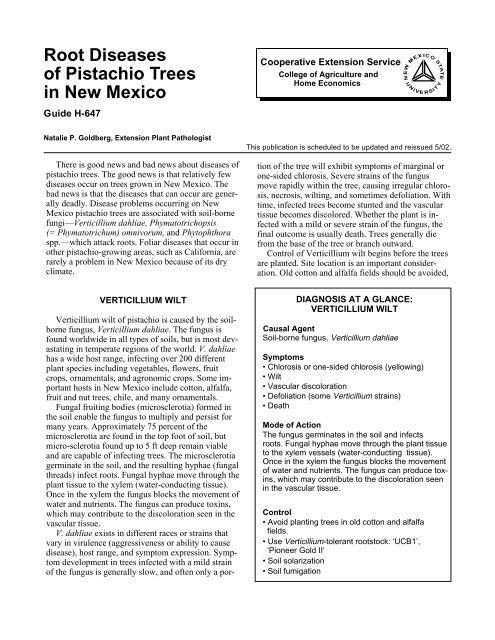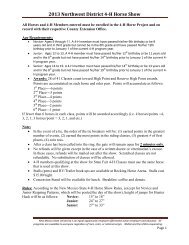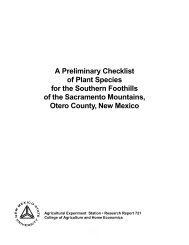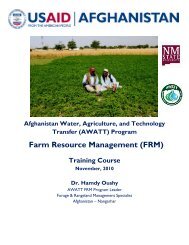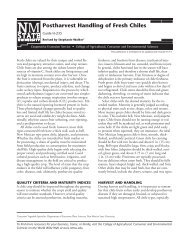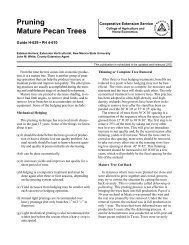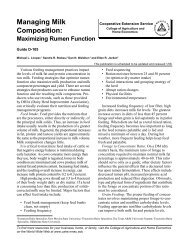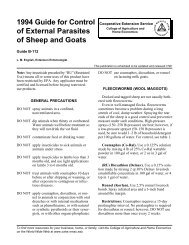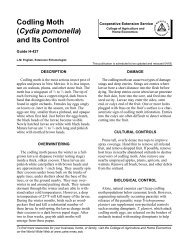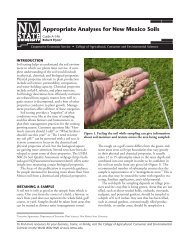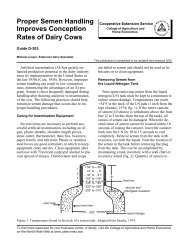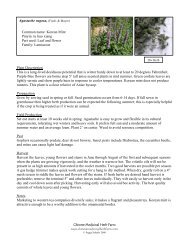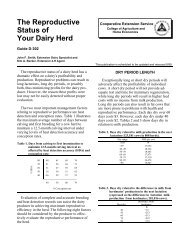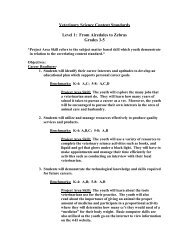Root Diseases of Pistachio Trees in New Mexico - NMSU's College ...
Root Diseases of Pistachio Trees in New Mexico - NMSU's College ...
Root Diseases of Pistachio Trees in New Mexico - NMSU's College ...
Create successful ePaper yourself
Turn your PDF publications into a flip-book with our unique Google optimized e-Paper software.
<strong>Root</strong> <strong>Diseases</strong><strong>of</strong> <strong>Pistachio</strong> <strong>Trees</strong><strong>in</strong> <strong>New</strong> <strong>Mexico</strong>Guide H-647Cooperative Extension Service<strong>College</strong> <strong>of</strong> Agriculture andHome EconomicsN EW MEXU NICOSTAEI V E R SI T YTNatalie P. Goldberg, Extension Plant PathologistThere is good news and bad news about diseases <strong>of</strong>pistachio trees. The good news is that relatively fewdiseases occur on trees grown <strong>in</strong> <strong>New</strong> <strong>Mexico</strong>. Thebad news is that the diseases that can occur are generallydeadly. Disease problems occurr<strong>in</strong>g on <strong>New</strong><strong>Mexico</strong> pistachio trees are associated with soil-bornefungi—Verticillium dahliae, Phymatotrichopsis(= Phymatotrichum) omnivorum, and Phytophthoraspp.—which attack roots. Foliar diseases that occur <strong>in</strong>other pistachio-grow<strong>in</strong>g areas, such as California, arerarely a problem <strong>in</strong> <strong>New</strong> <strong>Mexico</strong> because <strong>of</strong> its dryclimate.This publication is scheduled to be updated and reissued 5/02.Verticillium wilt <strong>of</strong> pistachio is caused by the soilbornefungus, Verticillium dahliae. The fungus isfound worldwide <strong>in</strong> all types <strong>of</strong> soils, but is most devastat<strong>in</strong>g<strong>in</strong> temperate regions <strong>of</strong> the world. V. dahliaehas a wide host range, <strong>in</strong>fect<strong>in</strong>g over 200 differentplant species <strong>in</strong>clud<strong>in</strong>g vegetables, flowers, fruitcrops, ornamentals, and agronomic crops. Some importanthosts <strong>in</strong> <strong>New</strong> <strong>Mexico</strong> <strong>in</strong>clude cotton, alfalfa,fruit and nut trees, chile, and many ornamentals.Fungal fruit<strong>in</strong>g bodies (microsclerotia) formed <strong>in</strong>the soil enable the fungus to multiply and persist formany years. Approximately 75 percent <strong>of</strong> themicrosclerotia are found <strong>in</strong> the top foot <strong>of</strong> soil, butmicro-sclerotia found up to 5 ft deep rema<strong>in</strong> viableand are capable <strong>of</strong> <strong>in</strong>fect<strong>in</strong>g trees. The microsclerotiagerm<strong>in</strong>ate <strong>in</strong> the soil, and the result<strong>in</strong>g hyphae (fungalthreads) <strong>in</strong>fect roots. Fungal hyphae move through theplant tissue to the xylem (water-conduct<strong>in</strong>g tissue).Once <strong>in</strong> the xylem the fungus blocks the movement <strong>of</strong>water and nutrients. The fungus can produce tox<strong>in</strong>s,which may contribute to the discoloration seen <strong>in</strong> thevascular tissue.V. dahliae exists <strong>in</strong> different races or stra<strong>in</strong>s thatvary <strong>in</strong> virulence (aggressiveness or ability to causedisease), host range, and symptom expression. Symptomdevelopment <strong>in</strong> trees <strong>in</strong>fected with a mild stra<strong>in</strong><strong>of</strong> the fungus is generally slow, and <strong>of</strong>ten only a portion<strong>of</strong> the tree will exhibit symptoms <strong>of</strong> marg<strong>in</strong>al orone-sided chlorosis. Severe stra<strong>in</strong>s <strong>of</strong> the fungusmove rapidly with<strong>in</strong> the tree, caus<strong>in</strong>g irregular chlorosis,necrosis, wilt<strong>in</strong>g, and sometimes defoliation. Withtime, <strong>in</strong>fected trees become stunted and the vasculartissue becomes discolored. Whether the plant is <strong>in</strong>fectedwith a mild or severe stra<strong>in</strong> <strong>of</strong> the fungus, thef<strong>in</strong>al outcome is usually death. <strong>Trees</strong> generally diefrom the base <strong>of</strong> the tree or branch outward.Control <strong>of</strong> Verticillium wilt beg<strong>in</strong>s before the treesare planted. Site location is an important consideration.Old cotton and alfalfa fields should be avoided,VERTICILLIUM WILTDIAGNOSIS AT A GLANCE:VERTICILLIUM WILTCausal AgentSoil-borne fungus, Verticillium dahliaeSymptoms• Chlorosis or one-sided chlorosis (yellow<strong>in</strong>g)• Wilt• Vascular discoloration• Defoliation (some Verticillium stra<strong>in</strong>s)• DeathMode <strong>of</strong> ActionThe fungus germ<strong>in</strong>ates <strong>in</strong> the soil and <strong>in</strong>fectsroots. Fungal hyphae move through the plant tissueto the xylem vessels (water-conduct<strong>in</strong>g tissue).Once <strong>in</strong> the xylem the fungus blocks the movement<strong>of</strong> water and nutrients. The fungus can produce tox<strong>in</strong>s,which may contribute to the discoloration seen<strong>in</strong> the vascular tissue.Control• Avoid plant<strong>in</strong>g trees <strong>in</strong> old cotton and alfalfafields.• Use Verticillium-tolerant rootstock: ‘UCB1’,‘Pioneer Gold II’• Soil solarization• Soil fumigation
as observations show that trees planted <strong>in</strong> these locationsare more likely to have problems associated withV. dahliae than trees planted <strong>in</strong> newly cultivated soils.Choice <strong>of</strong> rootstock is also important. When choos<strong>in</strong>grootstock for <strong>New</strong> <strong>Mexico</strong> orchards, several factorsshould be taken <strong>in</strong>to consideration <strong>in</strong>clud<strong>in</strong>g rate<strong>of</strong> growth, cold hard<strong>in</strong>ess, ease <strong>of</strong> budd<strong>in</strong>g, and toleranceto Verticillium. Other tree characteristics, such asnut yield, degree <strong>of</strong> shell splitt<strong>in</strong>g, blank nut production,and alternate bear<strong>in</strong>g, are also <strong>in</strong>fluenced byrootstock. Early research on pistachio rootstocks <strong>in</strong>dicatedthat trees produce and grow better on Pistaciaatlantica rootstock than on P. tereb<strong>in</strong>thus. Additionallybud take on P. tereb<strong>in</strong>thus tends to be more difficult<strong>in</strong> comparison with P. atlantica. However, P.tereb<strong>in</strong>thus has more cold hard<strong>in</strong>ess. Both <strong>of</strong> thesecommon rootstocks are susceptible to Verticilliumwilt. P. <strong>in</strong>tegerrima ‘Pioneer Gold’ rootstock exhibitsa high tolerance to this fungus. However, it possessesonly light tolerance to cold. A hybrid between P.<strong>in</strong>tegerrima and P. atlantica named ‘Pioneer Gold II’is somewhat more cold hardy, but also possesses toleranceto Verticillium. A vigorous, potentially coldhardy, Verticillium-tolerant hybrid has been developedat the University <strong>of</strong> California. This is a hybridbetween P. <strong>in</strong>tegerrima and P. lentiscus called‘UCB1’. All <strong>of</strong> the commonly used rootstocks are tolerantto root knot and lesion nematodes, though severeproblems associated with nematodes <strong>in</strong> pistachioorchards are rare.When trees become <strong>in</strong>fected with Verticillium, it isdifficult to control the disease. There are no fungicidesthat can be applied to <strong>in</strong>fected trees. In establishedorchards <strong>in</strong> grow<strong>in</strong>g regions with high summertemperatures, soil solarization may help to reduce thedisease’s severity. This procedure requires completetarp<strong>in</strong>g (us<strong>in</strong>g clear polyethylene) <strong>of</strong> the orchardfloor. Tarp<strong>in</strong>g applied after irrigation will raise thesoil temperature, reduc<strong>in</strong>g soil <strong>in</strong>oculum(microsclerotia and hyphae). When the tarp is left forover four weeks, Verticillium will be killed to a depth<strong>of</strong> about 4 ft. Soil solarization is expensive, but maybe worth the cost <strong>in</strong> mature orchards where manytrees are show<strong>in</strong>g symptoms <strong>of</strong> disease.In replant<strong>in</strong>g areas where trees have died as a result<strong>of</strong> Verticillium wilt, the plant<strong>in</strong>g site should be fumigatedwith sodium methyldithiocarbamate (Vapam ® )before replant<strong>in</strong>g. After fumigat<strong>in</strong>g, replant the sitewith a tree budded on Verticillium-tolerant root stock.PHYMATOTRICHUM ROOT ROTPhymatotrichum root rot, also known as Texas rootrot or cotton root rot, is caused by the soil-borne fungus,Phymatotrichopsis (= Phymatotrichum) omnivorum.There are no nice words to use when describ<strong>in</strong>gthis disease. This fungus has developed surefiresurvival techniques. Perhaps more important, there isno real control for the disease other than avoid<strong>in</strong>gland <strong>in</strong>fested with the fungus.This fungus is restricted to the southwestern UnitedStates and northern <strong>Mexico</strong> <strong>in</strong> alkal<strong>in</strong>e soils with loworganic matter content. It is typically found <strong>in</strong> relativelysmall areas. However, it can spread betweenplants through root grafts. It persists <strong>in</strong>def<strong>in</strong>itely <strong>in</strong>soil. Much <strong>of</strong> the fungus is found <strong>in</strong> the top 2–6 ft <strong>of</strong>soil, but sclerotia (fungal survival structures) havebeen found over 12 ft deep. P. omnivorum has an extremelywide host range, <strong>in</strong>fect<strong>in</strong>g over 2,000 species<strong>of</strong> dicotyledonous (broadleafed) plants. Furthermore,the fungus is capable <strong>of</strong> surviv<strong>in</strong>g on roots <strong>of</strong> nativevegetation, such as mesquite, without caus<strong>in</strong>g any diseasesymptoms. This is an important disease <strong>of</strong> cotton,alfalfa, fruit trees, and many ornamentals.DIAGNOSIS AT A GLANCE:PHYMATOTRICHUM ROOT ROTCausal AgentSoil-borne fungus, Phymatotrichopsis omnivorumSymptoms• Slight yellow<strong>in</strong>g and bronz<strong>in</strong>g <strong>of</strong> leaves• Wilt• Reddish lesion on crown• Rapid death (leaves rema<strong>in</strong> firmly attached)Signs• Fungal threads on roots (strands)• Spore mats around <strong>in</strong>fected treesConditions for Disease• Alkal<strong>in</strong>e soils• Soils low <strong>in</strong> organic matterControlAvoid <strong>in</strong>fested locations.Guide H-647 • Page 2
Symptoms first appear dur<strong>in</strong>g the summer when airand soil temperatures are high. The first evidence <strong>of</strong>disease is a slight yellow<strong>in</strong>g <strong>of</strong> the leaves. Quickly theleaves turn to a bronze color and beg<strong>in</strong> to wilt. Permanentwilt<strong>in</strong>g <strong>of</strong> the branches can occur very rapidly, aslittle as two weeks from the first expression <strong>of</strong> disease.The tree dies with the leaves rema<strong>in</strong><strong>in</strong>g firmlyattached. In some cases the tree wilts so quickly thatthe leaves hardly change color, though they will becomedry and brittle. A reddish lesion around thecrown <strong>of</strong> the tree develops on trees killed by this fungus.The fungus also produces signs (development <strong>of</strong>the pathogen on the host) on or near <strong>in</strong>fected trees. P.omnivorum produces fungal strands on the surface <strong>of</strong><strong>in</strong>fected roots. These strands are visible with a goodhand lens. When strands are observed under a microscope,cruciform (cross-shaped) hyphae unique to thisfungus can be seen. Another sign is the formation <strong>of</strong> awhite- to tan-colored spore mat on the surface <strong>of</strong> thesoil around <strong>in</strong>fected plants. Spore mats develop dur<strong>in</strong>gperiods <strong>of</strong> high moisture. The spores <strong>in</strong> these matshave never been germ<strong>in</strong>ated, and are considered tohave no function <strong>in</strong> survival or <strong>in</strong>fection <strong>of</strong> the pathogen.Therefore, spore mats do not spread disease, butare merely evidence <strong>of</strong> the presence <strong>of</strong> the fungus.Research to control this disease has been extensive,yet there are no good control methods available.There is no resistance or tolerance to this disease <strong>in</strong>pistachio rootstock. The best recommendation is toavoid land known to be <strong>in</strong>fested with the fungus. Furthermore,orchards should not be planted <strong>in</strong> old cottonand alfalfa fields. If mesquite land is to be cleared fororchard plant<strong>in</strong>g, it may be worth the time and moneyto preplant the area <strong>in</strong> cotton. If the cotton is stressedfor water, disease symptoms are generally noticeable<strong>in</strong> the first year. If no symptoms develop on the cotton,you can be relatively sure the land is safe forgrow<strong>in</strong>g pistachio trees.The ability <strong>of</strong> the fungus to survive deep <strong>in</strong> the soilhas elim<strong>in</strong>ated the possibility <strong>of</strong> us<strong>in</strong>g fungicides andfumigants to control the disease. Fumigat<strong>in</strong>g <strong>in</strong>festedplant<strong>in</strong>g holes (where trees have died) will usuallyonly delay the onset <strong>of</strong> disease.Certa<strong>in</strong> cultural practices can alter the soil environmentso that it no longer favors P. omnivorum. Thesepractices can help reduce the effectiveness <strong>of</strong> thepathogen; however, the procedure must be followedevery year. Otherwise the soil environment returns toits typical state (high pH and low organic matter), andaga<strong>in</strong> favors the fungus. The procedure consists <strong>of</strong>loosen<strong>in</strong>g the soil (just beyond the drip l<strong>in</strong>e), creat<strong>in</strong>ga comparatively shallow bas<strong>in</strong> around <strong>in</strong>fected trees.The area is then covered to a depth <strong>of</strong> 2 <strong>in</strong>. with manureor similar organic matter. Layered on top <strong>of</strong> theorganic matter is ammonium sulfate and sulfur, eachat a rate <strong>of</strong> 1 lb/10 ft 2 . Immediately flood the bas<strong>in</strong>with enough water to wet the soil to a depth <strong>of</strong> 3 ft.This high level <strong>of</strong> soil moisture must be ma<strong>in</strong>ta<strong>in</strong>edfor several weeks. If trees are treated before permanentwilt<strong>in</strong>g, they may recover. Remember that thistreatment must be applied each year.Some success <strong>in</strong> reduc<strong>in</strong>g the effect <strong>of</strong> the diseasehas been achieved by grow<strong>in</strong>g and <strong>in</strong>corporat<strong>in</strong>g agreen manure cover crop over the orchard floor. Thishelps to stimulate vigorous root<strong>in</strong>g <strong>of</strong> the trees, enabl<strong>in</strong>gthe trees to better withstand disease pressure.Additionally, the <strong>in</strong>corporation <strong>of</strong> the cover crop <strong>in</strong>tothe soil may help stimulate soil micr<strong>of</strong>lora that competewith P. omnivorum.F<strong>in</strong>ally, chemical barriers have been used to preventthe spread <strong>of</strong> disease from one tree to another.Us<strong>in</strong>g sulfur <strong>in</strong> trenches 4–6 <strong>in</strong>. wide and 4–6 ft deeparound the outside <strong>of</strong> the drip l<strong>in</strong>e <strong>of</strong> <strong>in</strong>fected treeshas prevented the spread <strong>of</strong> P. omnivorum for overseven years.CROWN ROTCrown rot, caused by the soil-borne fungus Phytophthoraspp., occurs only <strong>in</strong> areas with heavy, poorlydra<strong>in</strong>ed soils. This fungus is related to a group <strong>of</strong>fungi known as water molds. When the soil rema<strong>in</strong>ssaturated for a long time, the fungus is able to <strong>in</strong>fectsusceptible roots. Old trees are more susceptible todisease than young, vigorously grow<strong>in</strong>g trees.DIAGNOSIS AT A GLANCE:CROWN ROTCausal AgentSoil-borne fungus, Phytophthora spp.Symptoms• Rapid decl<strong>in</strong>e <strong>of</strong> tree• Chlorosis• Wilt• Death• No vascular discoloration (as <strong>in</strong> Verticillium wilt)Conditions for DiseaseWater logged, heavy soilControl• Ma<strong>in</strong>ta<strong>in</strong> vigorous trees.• Soil fumigation.Guide H-647 • Page 3
This fungus causes crown and root rot, typicallylead<strong>in</strong>g to the tree’s death. Crown rot is <strong>of</strong>ten misdiagnosedas Verticillium wilt, as the above-groundsymptoms are nearly identical. The disease is characterizedby a rapid decl<strong>in</strong>e <strong>in</strong> plant vigor. Infected treesmay turn yellow, wilt, and eventually drop theirleaves. This disease can be dist<strong>in</strong>guished from Verticilliumwilt by exam<strong>in</strong><strong>in</strong>g the vascular tissue <strong>of</strong> <strong>in</strong>fectedplants. If the tree is <strong>in</strong>fected with Phytophthorathere will be no discoloration <strong>of</strong> the vascular tissue,which is typical <strong>of</strong> Verticillium <strong>in</strong>fection.Vigorously grow<strong>in</strong>g trees appear to have a toleranceto Phytophthora. Thus, select<strong>in</strong>g vigorousrootstocks can help to reduce the <strong>in</strong>cidence <strong>of</strong> the disease.Additionally, ma<strong>in</strong>ta<strong>in</strong><strong>in</strong>g healthy trees withgood irrigation and fertilization practices is important<strong>in</strong> manag<strong>in</strong>g the disease. In locations where trees havedied from this disease, soil fumigation can be effective<strong>in</strong> reduc<strong>in</strong>g the fungus <strong>in</strong> the soil and is recommendedbefore replant<strong>in</strong>g.ReferenceCrane, J.C. and J. Maranto. 1988. <strong>Pistachio</strong> Production.Cooperative Extension Service, University<strong>of</strong> California, Division <strong>of</strong> Agriculture and NaturalResources. Publication 2279. 15 p.Additional Read<strong>in</strong>gFor more <strong>in</strong>formation on pistachio production, seeGrow<strong>in</strong>g <strong>Pistachio</strong>s <strong>in</strong> <strong>New</strong> <strong>Mexico</strong>, NMSU CooperativeExtension Service Circular 532. This publicationcan be ordered from Dept. <strong>of</strong> Agricultural Communications–Bullet<strong>in</strong>Office / <strong>New</strong> <strong>Mexico</strong> State University/ Box 30003, MSC 3AI / Las Cruces, NM 88003 /(505) 646-2701, or download the publication from ourWorld Wide Web site at http://www.cahe.nmsu.edu/cahe/redtops/circ532.pdf.<strong>New</strong> <strong>Mexico</strong> State University is an equal opportunity/affirmative action employer and educator. NMSU and the U.S. Department <strong>of</strong> Agriculturecooperat<strong>in</strong>g.May 1997 Las Cruces, NMGuide H-647 • Page 4


